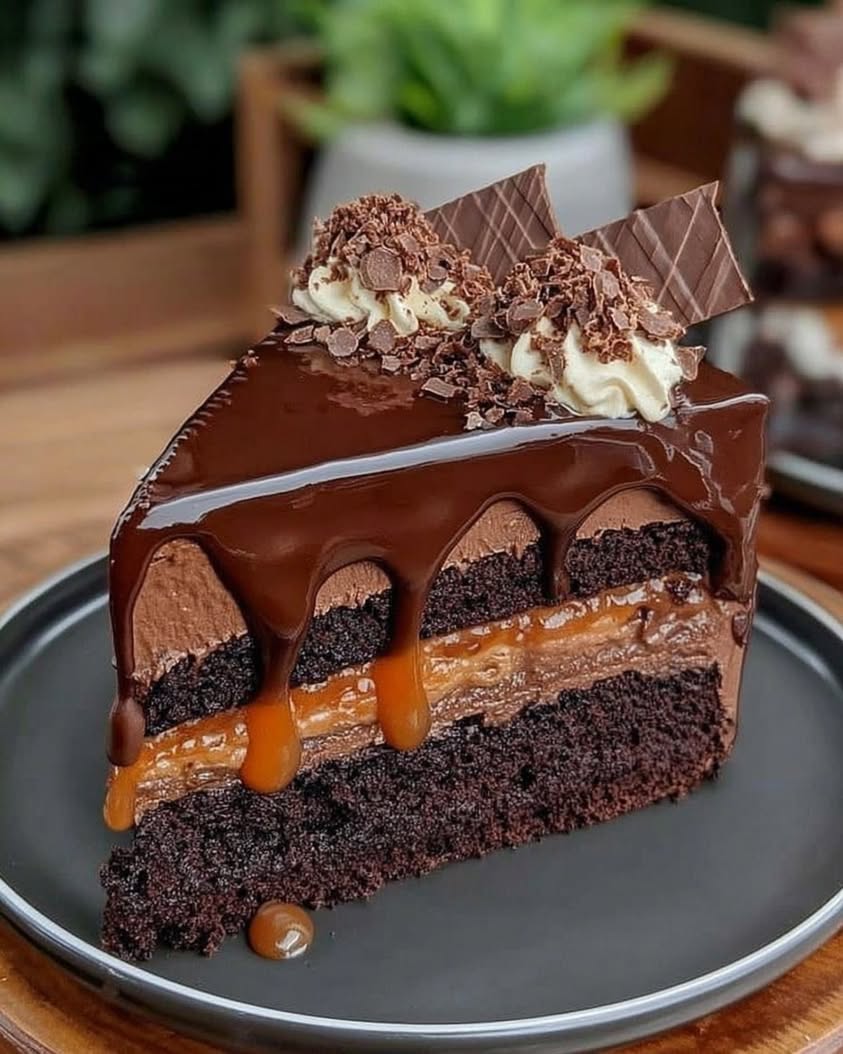Decadent Chocolate Cake: A Luxurious Delight
There’s something extraordinary about biting into a decadent chocolate cake—the moment when rich, velvety layers melt in your mouth and the intricate dance of chocolate expands your senses. A perfect treat for chocolate lovers, each slice promises both a visual marvel and a feast for the taste buds. This cake is designed for those special occasions when you want to impress but also savor its profound simplicity and luxury.
Creating this luxurious chocolate cake involves combining deep cocoa flavors with a hint of sweetness, achieving a harmonious balance between density and fluffiness. As you cut into it, the delicate crumb reveals itself, showcasing its soft, moist texture. The seductive aroma wafts through the kitchen, teasing the senses before the first taste. Presented with rich, dark hues, this cake is as much a treat to the eyes as it is to the palate, embellished with a smooth ganache or simple dusting of cocoa powder. While it requires a reasonable understanding of baking fundamentals, the rewards far exceed the efforts, with minimal special equipment required apart from basics like mixing bowls and a good-quality cake pan.
Quick Recipe Highlights
Flavor Profile: This decadent chocolate cake harmonizes bitter cocoa with subtle notes of sweetness, creating a rich, multidimensional flavor experience.
Texture: Experience a dense yet airy texture that provides a satisfying mouthfeel, enhancing each chocolatey bite without overpowering your taste buds.
Aroma: The sophisticated fragrance of cocoa and rich chocolate fills the air as the cake bakes, signaling its deliciousness even before it’s done.
Visual Appeal: The cake’s deep brown hue, paired with glossy ganache or a dusting of cocoa, creates an enticing visual presentation.
Skill Level Needed: With straightforward techniques, moderate baking skills are required, making this recipe accessible to enthusiasts looking to expand their repertoire.
Special Equipment: Beyond basic kitchen tools, you’ll need quality mixing bowls and a sturdy cake pan to achieve optimal results.
Recipe Overview
Difficulty Level: The moderate difficulty level reflects the precision involved in balancing ingredients and achieving the right texture, requiring some baking knowledge.
Category: As a dessert, this cake garners its place among indulgent treats, perfect for culminating special dinners or celebrations.
Cuisine: Rooted in European influences, this chocolate cake embodies a blend of classic culinary traditions featuring timeless ingredients like cocoa and sugar.
Cost: While high-quality chocolate and cocoa might increase the cost, the investment ensures the authenticity and depth of flavor that define this cake.
Season: Especially popular during colder months when rich, warm desserts are desired, yet timeless enough for any occasion through the year.
Occasion: Ideal for birthdays, anniversaries, or a simple weekend indulgence, this cake is versatile and universally loved.
Why You’ll Love This Recipe
The Decadent Chocolate Cake will become a staple in your dessert repertoire for myriad reasons. First, its rich, chocolatey taste is unparalleled, a genuine indulgence for true chocolate aficionados. The harmonious marriage of bittersweet cocoa and sugar delivers an exquisite balance, ensuring a flavor profile that deeply satisfies without being overwhelmingly sweet. With its luscious texture, each bite promises an experience that’s both light and substantial, dissolving smoothly on the tongue without heaviness.
Beyond its taste and texture, this cake provides the convenience of accessible preparation. This makes it a suitable choice for both planned and impromptu gatherings. Ingredients are straightforward and readily available, often requiring nothing more exotic than good quality cocoa powder. Preparation steps, though requiring attention to detail, are not overly complex, ensuring success as long as instructions are followed.
Nutritional benefits accompany the indulgence, with the cake offering a source of antioxidants through its rich cocoa content. For those mindful of dietary choices, portions can easily accommodate moderation, allowing you to enjoy without guilt.
From a social perspective, this cake shines as an entertainer’s delight. Its presentation and flavors make it a conversation starter, and its impressive results will elevate any event. As a centerpiece, it not only pleases the palate but also brings a touch of elegance to your table settings.
Cost-effectiveness and accessibility are other winning attributes. While it may command premium prices at bakeries, preparing this chocolate cake at home allows you to enjoy luxury on a budget. The ability to scale the recipe means it can fit both intimate dinner parties or larger gatherings efficiently.
Historical Background and Cultural Significance
The story of chocolate cake is as rich as the dessert itself, tracing its origins back to Europe in the 1760s when the use of cocoa powder in cakes emerged. Its evolution represents both cultural refinement and culinary experimentation, leading to the multifaceted interpretations we savor today. While cocoa was initially viewed as a luxury, its accessibility over time democratized the delight of chocolate desserts, integrated into Western culinary traditions.
Chocolate cake holds cultural significance, synonymous with celebration and indulgence. Each bite we take carries the weight of history—moments in kitchens where bakers tinkered with early recipes, shaping what would become a dessert icon. The association of chocolate with luxury and warmth persists, linking cultures through a shared appreciation of its unique taste.
Over centuries, the recipe has evolved, responding to changes in culinary technology and ingredient availability. The marriage of chocolate with other ingredients like vanilla and eggs pioneered new versions, while modern takes have embraced diverse textures and health-conscious modifications, showcasing the versatility of this beloved cake.
Regional variations have brought their own expressions to chocolate cake. From the dense Sachertorte of Austria to the airy sponge of American layer cakes, each adaptation brings local influences and flavors to the forefront, highlighting how regional tastes have shaped this universally adored dessert.
Ingredient Deep Dive
Cocoa is the heart of this decadent chocolate cake, its cultural and historical significance deeply rooted in its Mayan origins. Once deemed “the food of the gods,” cocoa spread to Europe where it catalyzed the creation of myriad chocolate desserts. Nutritionally, it offers antioxidants and mood-enhancing properties, making each bite both a treat and a health benefit.
To select cocoa, look for a rich, dark color and a strong chocolate scent, indicating quality. Proper storage involves keeping it in a cool, dark space within an airtight container to maintain freshness. Should cocoa not be available, high-quality unsweetened chocolate may substitute, altered to align with the recipe’s overall sweetness.
Butter, essential for the cake’s moisture and flavor, offers rich textures and enhances the chocolate while contributing its creamy essence. Nutritionally, it adds fat and some vitamins, balancing its indulgent quality. When choosing butter, opt for unsalted to control flavor accuracy. Store it in the fridge to preserve its quality, bringing to room temperature before use.
Flour, the building block of the cake, provides the necessary structure. All-purpose flour is recommended for its versatility. When storing, keep flour dry and free from moisture to prevent spoilage. Should you need alternatives, consider cake flour for lighter texture or gluten-free blends for dietary adaptations.
Common Mistakes to Avoid
Not measuring ingredients accurately can lead to issues with texture and flavor balance. Use a kitchen scale for precision.
Overmixing the batter results in a dense cake. Mix until just combined to preserve airiness.
Failing to preheat the oven can affect the cake’s rise and texture. Make sure the oven is fully preheated before baking.
Opening the oven door too early can cause the cake to deflate. Wait until at least two-thirds of the recommended baking time has elapsed.
Overbaking dries out the cake. Check for doneness with a toothpick; it should come out with a few crumbs attached.
Not cooling the cake properly before frosting may cause runny texture. Allow adequate cooling for structure integrity.
Ignoring the quality of ingredients compromises final flavor. Invest in high-quality cocoa and chocolate for best results.
Using cold ingredients can affect emulsification. Allow butter and eggs to reach room temperature before starting.
Essential Techniques
Achieving the perfect chocolate cake requires mastering a few essential techniques. Creaming butter and sugar is fundamental, creating a fluffy base by introducing air into the mix. Proper folding technique ensures that the dry ingredients are gently incorporated, maintaining a light texture crucial for a successful cake.
Understanding when the batter is just right is key. It should be smooth and slightly springy when touched. It’s crucial to avoid overmixing, which could lead to a dense and heavy cake. Lastly, observing the rise and pull of the cake from the tins are visual cues indicating readiness.
Pro Tips for Perfect Decadent Chocolate Cake
Always use room temperature ingredients to ensure a smooth and even blend.
Incorporate coffee into the mix; it enhances the depth of chocolate flavor without adding discernible coffee taste.
Use parchment paper at the bottom of the cake pan to prevent sticking and ensure easy removal.
Sift dry ingredients to achieve a smoother, more uniform batter free of lumps.
Incorporate chocolate chips for added richness and bursts of texture within the cake.
Do not skip resting periods between mixing and baking; it allows the batter to stabilize.
Variations and Adaptations
Regional variations of chocolate cake include rich flourless cakes, which swap flour for ground nuts, creating a velvety texture ideal for gluten-free diets. Seasonal touches like incorporating fresh berries or citrus zest can heighten flavors, ushering in bright notes that contrast with chocolate’s depth.
Adaptations for dietary needs are possible, with options like almond or coconut flour for gluten-sensitive consumers or using dairy-free substitutes for vegan adaptations. Flavor variations abound, with additions like spices or liqueurs for a nuanced experience.
Serving and Presentation Guide
For serving, use a sharp knife dipped in hot water for smooth, clean slices of chocolate cake. Plating is crucial; employ generous swirls of chocolate ganache or a dusting of powdered sugar to create an elegant look. Accompany slices with fresh berries or a dollop of whipped cream for contrast.
Traditional accompaniments like vanilla ice cream highlight the cake’s richness, while modern alternatives such as coulis or nut crumbles add intrigue. Temperature matters; serving slightly chilled or at room temperature can affect taste perception, offering different delights.
Wine and Beverage Pairing
Pair this decadent chocolate cake with a bold red wine like a Cabernet Sauvignon or a fruity Zinfandel, both balancing the cake’s intense chocolate notes. Non-alcoholic pairings may include a rich, full-bodied coffee or an aromatic chai tea, complementing the cake’s complexity.
Temperature considerations for beverages are important. Both room temperature reds and warm coffee or tea maintain the cake’s harmony, enhancing flavors without overshadowing them.
Storage and Shelf Life
To store, wrap the chocolate cake tightly in plastic wrap, keeping it in an airtight container at room temperature or slightly cooler. Avoid exposure to heat or sunlight which may cause melting. For longer storage, refrigerate or freeze, ensuring it is well-wrapped to prevent frost formation.
Be cautious of signs of spoilage such as off smells or mold. If reheating, gently warm the cake to prevent drying, safeguarding its original texture.
Make Ahead Strategies
When preparing in advance, align your schedule to bake the cake a day ahead. It releases its flavor overnight, creating an enriched taste experience. Between steps, ensure batter or dough is chilled if not immediately proceeding, which maintains its consistency until ready for use. Reheating calls for gentle methods to avoid drying out, with a focus on preserving moisture.
Scaling Instructions
For a smaller gathering, halving the recipe scales the chocolate cake effectively without loss of quality. When doubling or tripling, account for necessary equipment adjustments like larger baking trays or additional pans, ensuring even cooking. Storage adjustments involve separating portions to maintain quality.
Timing may also vary slightly with large-scale changes, requiring attentive monitoring to avoid over or undercooking.
Nutritional Deep Dive
Analyzing the nutritional profile, this cake offers a helpful breakdown of macronutrients, with significant calories stemming from fats and carbohydrates. Cocoa provides antioxidants benefiting heart health, while careful portion control allows for indulgence without excess. For dietary considerations, modifications such as using less sugar or replacing butter can tailor to specific health goals while maintaining flavor integrity.
Dietary Adaptations
For gluten-free versions, substitute regular flour with almond or coconut flour, ensuring structural integrity through careful emulsification. Dairy-free adaptations are achievable with plant-based milk and vegan butter, with slight flavor variations enhancing depth. At the same time, low-carb enthusiasts can employ sugar alternatives, allowing enjoyment without spiking blood sugar levels.
Troubleshooting Guide
Providing solutions for common baking challenges is essential for successful chocolate cake preparation. If experiencing texture issues such as dryness, focus on reducing bake time or increasing moisture through additional ingredients like yogurt or applesauce. For flavor balance concerns, adjust sweeteners or cocoa ratios, achieving harmonious taste.
Equipment challenges may include ensuring pan size aligns with recipes—too small a pan and cakes overflow, altering baking time. For ingredient substitutions, factor how alterations might impact overall taste and structure, adapting accordingly.
Recipe Success Stories
Reader feedback frequently highlights the Decadent Chocolate Cake for its rich flavor and easy-to-follow instructions, resulting in consistent success. Many have found innovation through variations, adding personal touches like different spices or frosting styles.
Suggestions such as adding espresso or creating tiered versions have been shared, showcasing versatility. Photography tips frequently involve leveraging natural lighting and vibrant garnishes for capturing the cake’s visual allure.
Frequently Asked Questions
Is it possible to make this recipe vegan?
Yes, substitute milk with plant-based alternatives, and use flaxseed for eggs, achieving similar binding and texture.
How can I store the cake to keep it fresh?
Wrap it tightly in plastic wrap and store in an airtight container at room temperature, or refrigerate for longer shelf life.
What makes a chocolate cake moist?
Using quality cocoa and butter, balancing sugar and liquid ingredients, and baking at correct temperatures ensure moisture.
Can I use self-raising flour instead of all-purpose flour?
Yes, but omit the baking powder and reduce salt, as self-raising flour already includes leavening agents.
How do I know when the cake is done?
Insert a toothpick into the center; it should come out mostly clean with a few crumbs for moist texture.
What’s the best way to frost the cake?
Ensure the cake is completely cooled; use an offset spatula for smooth, even spreading of ganache or frosting.
Can I add nuts or fruit to the cake?
Certainly, but chop and dry them well to prevent excess moisture affecting the cake’s texture.
How can I make the cake less sweet?
Reduce sugar as desired; consider adding more cocoa to maintain chocolate intensity.
Are there any gluten-free flour alternatives?
Almond or coconut flour can be used; ensure proper ratios and binding agents for structure.
What’s the significance of using room temperature ingredients?
Room temperature increases ingredient integration, resulting in even mixes and desirable structure.
Additional Resources
For enthusiasts seeking further culinary expertise, explore related chocolate recipes that extend beyond cake, diving into brownies or truffles. Technique guides provide step-by-step visually driven instructions enhancing baking skills, while ingredient information delves deeper into the nuances of cocoa and chocolate varieties. Equipment recommendations assist in building a well-rounded kitchen, attuned to both novice and expert needs.
Embrace seasonal variations, celebrating the versatility of chocolate in all its delicious forms throughout the year, ensuring satisfaction in every bite.
Print
Decadent Chocolate Cake
Description
A rich and moist chocolate cake perfect for any celebration.
Ingredients
For the Crust:
- 1 and 3/4 cups all-purpose flour
- 3/4 cup unsweetened cocoa powder
- 2 cups granulated sugar
- 1 and 1/2 teaspoons baking powder
- 1 and 1/2 teaspoons baking soda
- 1 teaspoon salt
- 2 large eggs
- 1 cup whole milk
- 1/2 cup vegetable oil
- 2 teaspoons vanilla extract
- 1 cup boiling water
Instructions
1. Prepare the Crust:
- Preheat your oven to 350°F (175°C) and grease two 9-inch round baking pans.
- In a large bowl, combine flour, cocoa powder, sugar, baking powder, baking soda, and salt.
- Add eggs, milk, oil, and vanilla to the dry ingredients and mix until smooth. Stir in boiling water (batter will be thin).
- Pour batter evenly into prepared pans and bake for 30-35 minutes, or until a toothpick inserted into the center comes out clean.
- Cool cakes in the pans for 10 minutes, then remove to wire racks to cool completely.
Notes
You can customize the seasonings to taste.





